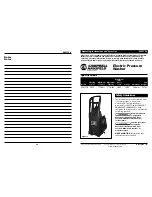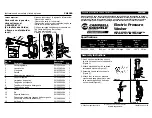
308–507
5
STARTUP
Use this procedure whenever starting the pressure
washer to help insure that the unit is ready to operate and
starting is done safely.
1. Turn on the water supply.
CAUTION
Never run the unit dry. Costly damage to the pump
will result. Always be sure the water supply is
completely turned on before operating.
2. Turn on the air supply.
3. Trigger the gun to start.
4.
ALWAYS engage the gun’ s trigger safety latch
whenever you stop spraying, even for a moment, to
reduce the risk of fluid injection or splashing in the
eyes or on the skin if the gun is bumped or triggered
accidentally.
5.
ALWAYS observe the following
CAUTIONS
to avoid
costly damage to the pressure washer.
CAUTION
DO NOT run the pump dry , which will quickly
damage the pump. Be sure the water supply is
fully turned on before starting the pump.
DO NOT operate the pressure washer with the inlet
water screen removed. This screen helps keep
abrasive sediment out of the pump, which could
clog or scratch the pump. Keep this screen clean.
DO NOT pump caustic materials; such materials
may corrode the pump components.
OPERATION
Two factors control the flowrate and spray pressure of
Graco air–powered pressure washers: the orifice size of
the spray tip and the air inlet pressure. Adjust these
factors to get the desired flowrate and spray pressure,
but never allow the pump to exceed 60 cpm. To increase
the flowrate, increase the spray tip orifice or the air inlet
pressure. Both factors will increase the pump speed, but
the larger tip orifice will reduce the spray pressure. T o
increase the spray pressure, increase the air inlet
pressure.
Adjustable Nozzle (800–412 & 800–413)
Insert the chemical filter (attached with the clear tubing to
the chemical injector) into the container of chemical. Turn
the control ring on the adjustable nozzle clockwise. This
causes a drop in pressure that actuates the chemical
injector. Closing the adjustable nozzle deactivates the
chemical injector and produces high pressure for rinsing.
The flow rate of the chemical may be regulated by turning
the chemical adjustment knob on the injector. Maximum
chemical flow is at a full two turns counterclockwise from
the closed (clockwise) position.
WARNING
DO NOT attempt to open or close the adjustable
nozzle when the spray gun is in use.
BE SURE that
the trigger safety latch on the gun is in the “ON”
position before adjusting to avoid serious bodily
injury or fluid injection.
Changeable Spray Tips (800–295 only)
Insert the chemical filter (attached with the clear tubing to
the chemical injector) into the container of
chemical.
Install the large orifice chemical tip (see Installing and
Changing Spray Tips). This causes a drop in pressure
that actuates the chemical injector. Changing back to a
small diameter spray tip deactivates the chemical injector
and produces high pressure for rinsing. The flow rate of
the chemical may be regulated by turning the chemical
adjustment knob on the injector. Maximum chemical flow
is at a full two turns counterclockwise from the closed
(clockwise) position.
Cleaning
No more than 100 feet (30 m) of spray hose may be used
between the chemical injector and the spray gun when
the operator is at the same level as the chemical injector.
If the operator is over 25 feet above the chemical injector,
no more than 50 feet (15 m) may be used.
Check the distance that you will need to hold the spray
nozzle from the surface by test spraying on a scrap of
similar material. For soft surfaces, such as wood, hold the
nozzle about 3 ft (1 m) from the surface and gradually
bring it closer, checking to see if the high pressure spray
is damaging the surface.
Mist wet the surface with cleaning solution, moving from
bottom to top. Let it soak briefly
, then use the high
pressure rinse to “chisel” off the soil, moving from top to
bottom. Keep the nozzle angled to the surface and at a
distance determined to be best for the surface. If some
soil remains, repeat the procedure, letting the chemical
soak a little longer. Stubborn soil can be cleaned off better
with a stronger, heated cleaning solution.
Protect surfaces that might be damaged by the cleaning
solution or high pressure spray. Rinse the solution before
it dries.


































